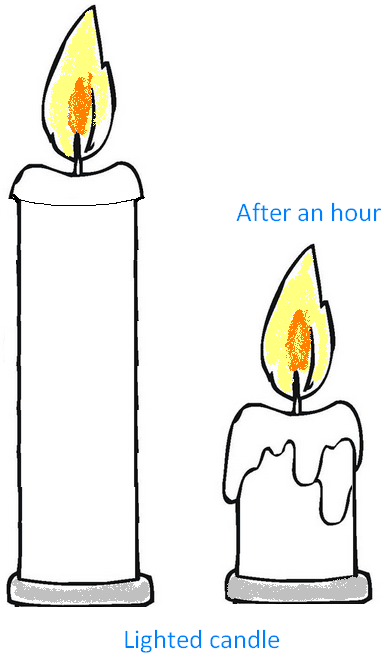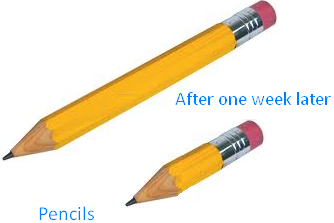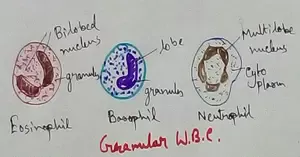Changes in The World Around Us
We can see many changes in the world around us. The world around us has many living things. All living things change as they grow.
For example:
(i) A pup becomes a dog.
(ii) Kitten grows into a cat.
(iii) A calf becomes a cow.
Non-living things may also change.
For example:
(i) Ben blows into a balloon. How will the balloon look afterwards you can blow a balloon and see it practically.
(ii) What happens when Ben pulls
a rubber band? When Ben lets go of the rubber band, what happens?
What changes can you see in these things?
(i) Light a candle and then see after an hour.
(ii) A new pencil used and then after one week later.
All these things changed their size. Some things change their shape.
We watch our mother making chapattis. As she rolls out the dough, it changes its shape.
There are many other changes you can see around you. We have noticed that the Moon changes its shape every night.
Now we will discuss about other changes you notice every day.
Some changes in nature take place in different seasons.
Some trees lose their leaves in winter. Other trees lose their leaves in summer. Some trees have flowers in summer. Some have fruit in summer, others have fruit in winter. These changes happen every year.
Fruit ripen in a warm place and often their color changes.
Can you name a fruit that changes its color when it ripens? Color of unripe mango is green and ripe mango is yellow.
Some other changes happen because of heating.
What happens when a match burns?
When a match burns, it changes color. It turns black. It looks different.
What happens when a piece of paper burns?
It turns brown and then black.
If a piece of coal is burnt, it changes into ash. The coal was hard and black. The ash is grey and soft.
Ask your teacher or parents to show you these changes. Never light matches on your own. You may get badly hurt.
Ask your mother to show you some uncooked rice. Look at the cooked rice that you eat. Which one is hard? Which one is soft and fluffy? Most foods become soft and ready to eat when they are cooked.
What happens to ice cubes when they are left out in a warm place?
It starts melting.
These are the examples of some of the changes in the world around us.
From Changes in The World Around Us to HOME PAGE
Recent Articles
-
Formed Elements of Blood | Erythrocytes | ESR |Leukocytes |Neutrophils
Jan 15, 26 01:25 AM
Formed elements formed elements are constitute about 45 % of blood afeias haematocrit value packed cell volume mostly of red blood corpuscles and are of 3 types- erythrocytes, leukocytes and blood pla… -
What Is Plasma? | Blood Plasma | Proteins | Nutrients | Cholesterol
Nov 07, 25 10:29 AM
Blood is a mobile fluid which is a connective tissue and is derived from the mesoderm like cell any other connective tissue. Colour of blood is reddish and that flows inside the blood vessels by means… -
Disorders of Respiratory System | Tuberculosis | Pleurisy | Emphysema
Oct 28, 25 11:39 PM
Tuberculosis is very common disease and is caused by a type of bacteria called Mycobacterium tuberculosis. This disease causes different trouble in the respiration and infection of several parts of th… -
Regulation of Respiration | Respiratory Centres | Inspiratory Area |
Oct 14, 25 12:13 AM
Respiratory Centre is the area that controls the rate of respiration and it is observed to be located in medulla oblongata and pons. Respiratory Centre has the following will dispersed components like… -
Explain Transport of Gases | External Respiration | Tissue Respiration
Oct 09, 25 11:35 PM
In humans gaseous exchange is completed in the following ways the steps are - External Respiration or Breathing - Breathing in false taking in of Oxygen and giving out of carbon dioxide in the body. M…







New! Comments
Have your say about what you just read! Leave me a comment in the box below.